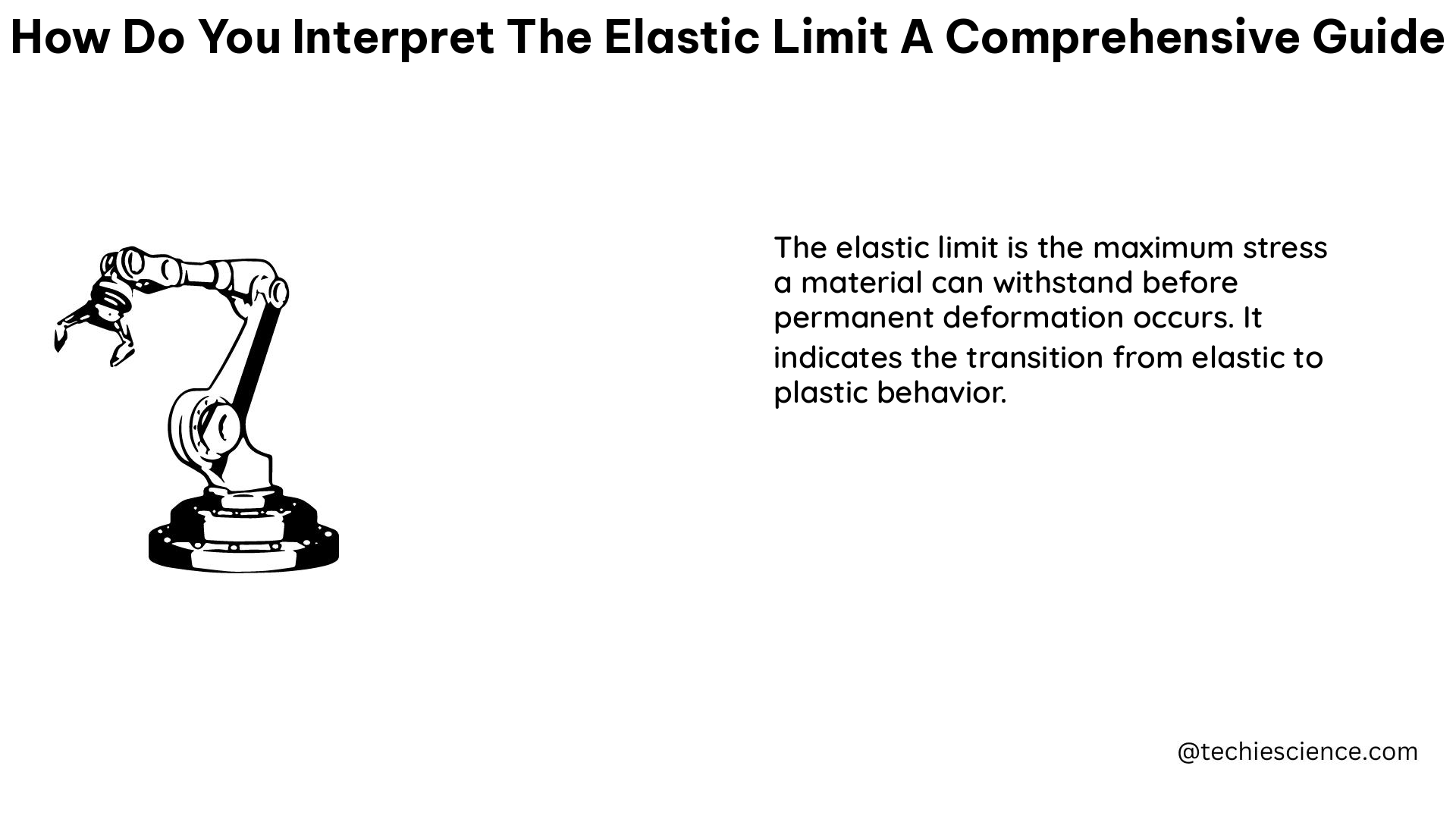The elastic limit is a crucial concept in Mechanical Engineering, as it defines the maximum stress a material can withstand before experiencing permanent deformation. Accurately interpreting the elastic limit is essential for designing safe and reliable structures, components, and systems that can withstand the forces they will encounter during their service life. This comprehensive guide will delve into the various techniques and methods used to interpret the elastic limit, providing Mechanical Engineering students and professionals with a deep understanding of this fundamental material property.
Understanding the Elastic Limit
The elastic limit, also known as the proportional limit, is the maximum stress a material can experience before it begins to exhibit permanent, non-recoverable deformation. This point marks the transition from the material’s elastic region, where the deformation is reversible, to the plastic region, where the deformation becomes permanent.
The elastic limit is typically determined through stress-strain testing, where a material sample is subjected to increasing levels of stress, and the corresponding strain is measured. The stress-strain curve generated from this testing can be used to identify the elastic limit, as well as other important material properties, such as the yield strength and ultimate tensile strength.
Quantitative Micro-Elastography

Quantitative micro-elastography is a powerful technique used to image and measure the elasticity of materials, including biological tissues. This method involves applying a known stress to a sample and then measuring the resulting strain, allowing for the calculation of the material’s elastic modulus or Young’s modulus.
In a study published in the journal Scientific Reports, researchers used quantitative micro-elastography to assess the elasticity of seven homogeneous silicone phantoms with expected elasticity values ranging from 5 to 180 kPa. The measured elasticity values matched the expected values to within 8%, demonstrating the high accuracy of this technique.
This method is particularly useful for interpreting the elastic limit of biological tissues, such as breast tissue, where understanding the material’s elastic behavior is crucial for predicting its response to real-world loads and ensuring its durability.
Strain Testing
Strain testing is another essential method for interpreting the elastic limit of materials. By measuring the deformation or change in shape a material experiences due to applied stress, engineers can calculate the material’s yield strength, ultimate tensile strength, and elastic limit.
The stress-strain equation, σ = F/A, relates the applied force (F) to the cross-sectional area (A) of the material, while the Young’s modulus formula, E = σ/ε, relates the stress (σ) to the strain (ε) and provides a measure of the material’s stiffness.
These values provide crucial information about a material’s overall strength and durability, helping engineers predict how a material will perform under real-world loads and ensuring it can withstand the forces it will encounter during its service life.
Mechanical Engineering Applications
The elastic limit is a critical consideration in the design of various Mechanical Engineering structures and components. In the design of buildings and bridges, for example, understanding the elastic limit of the construction materials is essential for ensuring structural integrity and safety.
Similarly, in the automotive and aerospace industries, strain testing is used to assess the durability of components like frames, axles, and wings, ensuring that these parts can withstand the extreme forces they will encounter during operation.
Factors Affecting the Elastic Limit
When interpreting the elastic limit, it is essential to consider various factors that can influence a material’s elastic behavior, such as:
- Material Composition: The chemical composition and microstructure of a material can significantly impact its elastic properties.
- Material Processing History: The manufacturing processes used to produce a material, such as heat treatment or cold working, can alter its elastic behavior.
- Temperature: Changes in temperature can affect a material’s elastic limit, as higher temperatures can lead to increased molecular mobility and reduced resistance to deformation.
- Loading Rate: The rate at which a load is applied can also influence the elastic limit, as materials may exhibit different behavior under static or dynamic loading conditions.
- Environmental Conditions: Factors like humidity, corrosive environments, and radiation can all impact a material’s elastic properties over time.
Understanding the effects of these factors is crucial for accurate material characterization and reliable design in Mechanical Engineering applications.
Conclusion
Interpreting the elastic limit is a fundamental aspect of Mechanical Engineering, as it provides crucial insights into a material’s strength, durability, and resistance to deformation. By utilizing techniques like quantitative micro-elastography and strain testing, engineers can accurately determine a material’s elastic limit and other essential properties, enabling the design of safe and efficient structures, components, and systems.
This comprehensive guide has explored the various methods and considerations involved in interpreting the elastic limit, equipping Mechanical Engineering students and professionals with the knowledge and tools necessary to make informed decisions and ensure the reliability of their designs.
References
- Ormachea, J., Castaneda, E. G., & Hossack, J. A. (2015). Quantitative micro-elastography: Imaging of tissue elasticity using compression optical coherence elastography. Scientific Reports, 5, 13538. https://doi.org/10.1038/srep13538
- Interface Force Measurements. (n.d.). Strain Testing 101. https://www.interfaceforce.com/strain-testing-101/
- Encord. (2021, May 11). Mastering Supervised Learning: A Comprehensive Guide. https://encord.com/blog/mastering-supervised-learning-a-comprehensive-guide/

The lambdageeks.com Core SME Team is a group of experienced subject matter experts from diverse scientific and technical fields including Physics, Chemistry, Technology,Electronics & Electrical Engineering, Automotive, Mechanical Engineering. Our team collaborates to create high-quality, well-researched articles on a wide range of science and technology topics for the lambdageeks.com website.
All Our Senior SME are having more than 7 Years of experience in the respective fields . They are either Working Industry Professionals or assocaited With different Universities. Refer Our Authors Page to get to know About our Core SMEs.